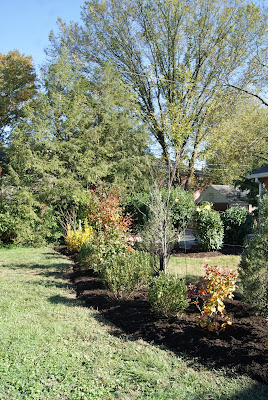
Hedgerows can be planted for many reasons, and before planting a hedgerow it is important to define what the primary objectives are for the hedgerow.
Possible objectives for a hedgerow can include:
Windbreak (perhaps on the north side of a home or to provide a sheltered area of the garden).
Privacy (best to select mostly evergreen species)
To provide habitat for birds, butterflies, bees and small animals
To beautify a garden
To define a space within a garden
To create a boundary
As a place to plant native species for ecological reasons
To provide edible nuts and berries for people
Fragrant Blossoms
When I am asked by a homeowner to create a design for a hedgerow I first determine what the primary objectives are and then tailor the design to fill these objectives. Perhaps the simplest and most over planted hedgerow is the typical row of giant arborvitae that create a full privacy screen and boundary. While this hedgerow certainly has its place and function, it is not always the best choice for a homeowner. A more diverse planting can be much more attractive, interesting and useful in the home setting.
In this particular situation the homeowners wanted the hedgerow to define a boundary and offer some privacy without being the typical set of evergreens planted in a dull row. We arrived at a suitable design that combined a number of wonderful native species of trees and shrubs with some non-natives that held special appeal. This hedgerow offers 4 season interest with blooms at various times of the year and various bark textures and colors that come into their true glory during winter.

Creating a hedgerow in an area that has been lawn is a process of removing the sod, tilling and enhancing the topsoil as needed (leaf compost being a great choice), planting the new trees and shrubs and mulching generously. This hedgerow is designed to have a non-linear shape even though it is defining a linear boundary between the homeowner and neighbor. The gentle curve suits the diverse planting well. Over time this hedgerow will fill out and attract many birds and beneficial insects. We also selected varieties that offer scented blooms.
Varieties here included:
Juniper (evergreen)
Kousa Dogwood (chinese, more disease resistant)
Redbud (native flowering)
Japanese Stewartia (flowering, winter interest)
Serviceberry (native, flowering)
Shrubs:
Inkberry (evergreen native)
Skip laurel (evergreen)
Red Twig Dogwood (native, winter interest)
Dwarf Fothergilla (native fragrant flowering spring)
Summersweet (fragrant flowering summer)
Viburnum (fragrant flowering spring)
Witch Hazel (native fragrant flowering autumn)

Note that there is a mixture of evergreens and deciduous, natives and non-natives. This is a flexible design that takes into consideration the diverse purposes for this hedgerow. As a garden designer who also installs the design, I strive to meet the needs of the homeowner while also contributing to a positive ecology and supporting the planting of native species. There are many beautiful native species that are entirely appropriate for the home garden, however I am not a purist in the sense of only promoting native species. The sharing of species between regions and continents has been going on for thousands of years. However, I do avoid planting invasive species as I know first hand how difficult they are to remove, however we can all enjoy the many exotic species that have become readily available in our local nurseries.






No comments:
Post a Comment